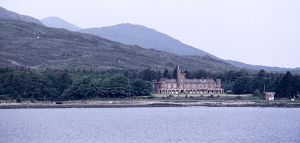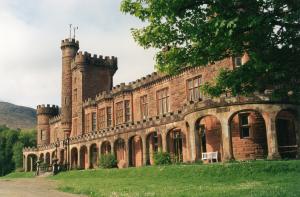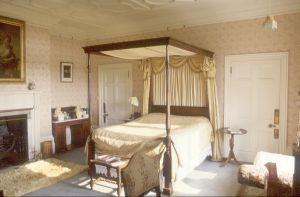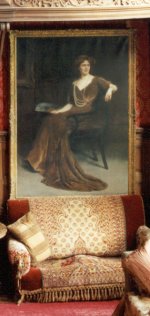KINLOCH CASTLE FRIENDS ASSOCIATION - The Castle
|
|
The Duke and Duchess of Rothesay visited Kinloch Castle on 1 June 2006. Our Secretary met the Duke and Duchess during their visit. His report may be read by following this internal link. |
It is said that Sir George wanted to build the castle the same length as his steam yacht, the Rhouma, which measured 221ft. The story goes that the final design could "only" be 150 ft due to two streams running down to the sea obstructing the site. However, an examination of the site shows that it could easily have accommodated the larger length so the final design was more likely to be to aesthetic. The castle has a colonnaded veranda on three sides which was originally roofed with glass. A large glass conservatory, which no longer survives, was constructed on the south side with direct access from the drawing room.
From the beginning the house was lit by electricity from its own hydro-electric scheme powered by water from a reservoir in Coire Dubh. The internal telephone system was the first in Scotland. Music could (and still can) be provided automatically by an electrically driven "Orchestrion" able to produce the effect of a 40 piece orchestra using punched paper or brass rolls. Further information about the instrument can be found in an article written by our Honorary Secretary, Douglas King, in July 2006.
An initial lottery fund application is being put together which was expected to be submitted by SNH early in 2002 though this date was not met. The Castle was featured in the BBC "Restoration" programme in 2003 and reached the finals. Unfortunately it did not win so the future is still in doubt. The more people who express their interest in the Castle the better the chances of a favourable outcome. If you would like to join our organisation and lend your weight to our efforts please follow the link to our "contact" page and send us an e-mail. |
 As
you sail up Loch Scresort towards the new landing stage on Rum, Kinloch
Castle dominates the view at the head of the bay. Today it is
surrounded by trees but early pictures show it in isolated splendour
in open country. The Castle remains the most intact Edwardian
country house in Britain.
As
you sail up Loch Scresort towards the new landing stage on Rum, Kinloch
Castle dominates the view at the head of the bay. Today it is
surrounded by trees but early pictures show it in isolated splendour
in open country. The Castle remains the most intact Edwardian
country house in Britain. The Castle was built for Sir (then simply Mr) George Bullough
in the last years of the 19th and first years of the 20th centuries
and completed around 1901. It was first occupied not by the owner
but by convalescing officers wounded in the Boer War. The architects
were the firm of Leeming and Leeming of London who's other commissions
included the Admiralty in London and the Municipal Buildings
in Edinburgh. It is constructed from red sandstone which was
obtained from Corsehill Quarry 2 miles north of Annan in Dumfries-shire, some 160 miles from Rum (not from the island of Arran in the Firth of Clyde as has been reported). The stone was shipped in on those classic west coast of Scotland work-horses, the "puffer". Annan stone was used because the local stone was not suitable for use a fine building stone.
The Castle was built for Sir (then simply Mr) George Bullough
in the last years of the 19th and first years of the 20th centuries
and completed around 1901. It was first occupied not by the owner
but by convalescing officers wounded in the Boer War. The architects
were the firm of Leeming and Leeming of London who's other commissions
included the Admiralty in London and the Municipal Buildings
in Edinburgh. It is constructed from red sandstone which was
obtained from Corsehill Quarry 2 miles north of Annan in Dumfries-shire, some 160 miles from Rum (not from the island of Arran in the Firth of Clyde as has been reported). The stone was shipped in on those classic west coast of Scotland work-horses, the "puffer". Annan stone was used because the local stone was not suitable for use a fine building stone. The interior of the Castle remains much as it was when the family last used it. The photograph shows Lady Bulloughs bedroom which the writer was able to use during a stay on Rum. The bathrooms, en-suite in some rooms, are a plumbers nightmare. The baths incorporate shower enclosures with a complex set of taps to control water which can be hot or cold, come down in a stream or spray, come up in a spray or jet, or even spray in from the side!
The interior of the Castle remains much as it was when the family last used it. The photograph shows Lady Bulloughs bedroom which the writer was able to use during a stay on Rum. The bathrooms, en-suite in some rooms, are a plumbers nightmare. The baths incorporate shower enclosures with a complex set of taps to control water which can be hot or cold, come down in a stream or spray, come up in a spray or jet, or even spray in from the side! In 1957 the Island of Rum and the Castle passed into public ownership
through the sale by Lady Bullough to the Nature Conservancy (the predecessor of the current owners Scottish Natural Heritage). The picture to the right is a portrait of Lady Bullough which hangs in the Great Hall.
There was a stipulation that the island "be used in perpetuity as a nature reserve and
In 1957 the Island of Rum and the Castle passed into public ownership
through the sale by Lady Bullough to the Nature Conservancy (the predecessor of the current owners Scottish Natural Heritage). The picture to the right is a portrait of Lady Bullough which hangs in the Great Hall.
There was a stipulation that the island "be used in perpetuity as a nature reserve and